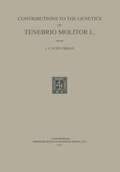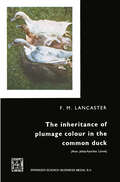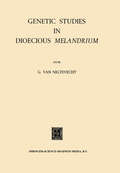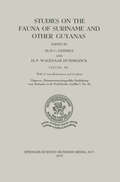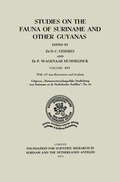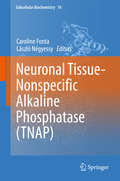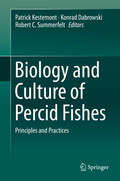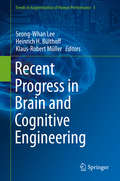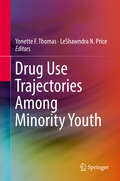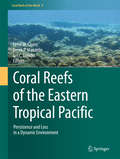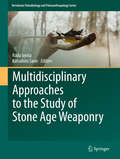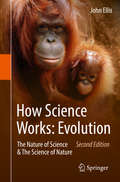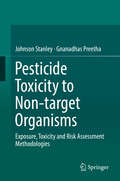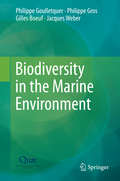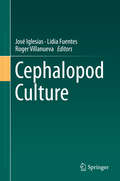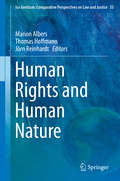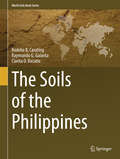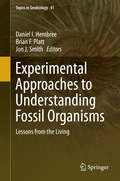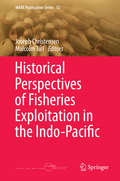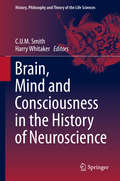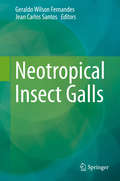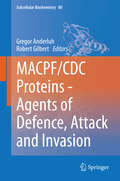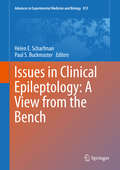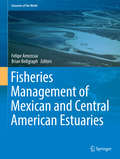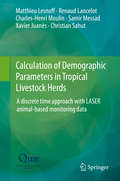- Table View
- List View
Studies on the Fauna of Suriname and other Guyanas: Volume XV
by D.C. Geijakes P. Wagenaar HummelinckStudies on the Fauna of Suriname and other Guyanas: Volume XVI
by D.C. Geijakes P. Wagenaar HummelinckNeuronal Tissue-Nonspecific Alkaline Phosphatase (Subcellular Biochemistry #76)
by Caroline Fonta László NégyessyPhosphatases, such as TNAP are fundamental in regulating the roles of cellular, and consequently numerous body functions. TNAP is a ubiquitous enzyme with a wide spectrum of substrates and specificity. Regulation at the cellular level and the lack of TNAP activity is a lethal condition. Recent findings of a highly specific regional, laminar and subcellular localization of TNAP in the cerebral cortex indicates that in addition to its metabolic and skeletal functions, TNAP also plays a role in regulating cerebral functions, most probably cognition. In fact, TNAP disturbance could result in complex diseases such as epilepsy, developmental retardation and Alzheimer's disease. Available data suggest that, regarding brain functions, TNAP is a potentially important target of clinical research. This book aims to provide an overview of our current understanding of the functions of TNAP in the brain and on other tissues and organs.
Biology and Culture of Percid Fishes: Principles and Practices
by Patrick Kestemont Konrad Dabrowski Robert C. SummerfeltThis extensive work focuses on an important group of temperate freshwater fish, approaching the topic from the perspectives of both biology and aquaculture. It compiles the latest research on fish belonging to the Percidae family and describes in detail all biological aspects relevant to the culture of different species, including ecology, reproductive physiology, feeding and nutrition, genetics, immunology, stress physiology and behavior. It also considers commercial fish production and fish farming topics, such as protocols for induction of gonad maturation, spawning, incubation and larval rearing.Expert contributors not only provide a critical peer review of scientific literature but also original research data, and identify effective practical techniques. The book features chapters on systematics, ecology and evolution, on development, metabolism and husbandry of early life stages and on growth, metabolism, behavior and husbandry of juvenile and grow-out stages. Furthermore, the authors consider genetic improvement and domestication, as well as diseases and health management, crucial to the readers' understanding of these fish and how they can be cultured.Both researchers of percid fish biology and aquaculture professionals who are considering intensive and pond culture of percid fishes will value this timely and comprehensive handbook.)
Recent Progress in Brain and Cognitive Engineering (Trends in Augmentation of Human Performance #5)
by Seong-Whan Lee Heinrich H. Bülthoff Klaus-Robert MüllerFor ‘Recent Progress in Brain and Cognitive Engineering’Brain and Cognitive Engineering is a converging study field to derive a better understanding of cognitive information processing in the human brain, to develop “human-like” and neuromorphic artificial intelligent systems and to help predict and analyze brain-related diseases. The key concept of Brain and Cognitive Engineering is to understand the Brain, to interface the Brain, and to engineer the Brain. It could help us to understand the structure and the key principles of high-order information processing on how the brain works, to develop interface technologies between a brain and external devices and to develop artificial systems that can ultimately mimic human brain functions. The convergence of behavioral, neuroscience and engineering research could lead us to advance health informatics and personal learning, to enhance virtual reality and healthcare systems, and to “reverse engineer” some brain functions and build cognitive robots.In this book, four different recent research directions are presented: Non-invasive Brain-Computer Interfaces, Cognitive- and Neural-rehabilitation Engineering, Big Data Neurocomputing, Early Diagnosis and Prediction of Neural Diseases. We cover numerous topics ranging from smart vehicles and online EEG analysis, neuroimaging for Brain-Computer Interfaces, memory implantation and rehabilitation, big data computing in cultural aspects and cybernetics to brain disorder detection. Hopefully this will provide a valuable reference for researchers in medicine, biomedical engineering, in industry and academia for their further investigations and be inspiring to those who seek the foundations to improve techniques and understanding of the Brain and Cognitive Engineering research field.
Drug Use Trajectories Among Minority Youth
by Yonette F. Thomas LeShawndra N. PriceThis volume examines trajectories of drug use among ethnic minority youth in the United States with a focus on African Americans and Hispanics. It also highlights what research designs have been employed to address these differences as well as suggests strategies for moving this discourse forward by identifying potential targets for prevention and intervention with minority youth. This book features essays by leading experts in the field who have grappled with this issue for decades. Inside, readers will find an insightful dialogue that addresses such questions as: Why are African American and Hispanic youth more likely than their White peers to abstain from drug use during adolescence but are more likely to become problem users later in life? What impact does the stress caused by discrimination have on potential drug use? To what extent does religiosity protect minority youth from drug use as past research suggests that it protects White youth? What is the influence of neighborhood context on exposure to and use of substances among urban African American children? Taken together, the essays in this book identify underexplored risk and protective factors and gaps in the current state of knowledge that can be used to develop effective, culturally specific drug abuse prevention strategies. This book is for anyone with an interest in the initiation and escalation of drug use among African Americans and Hispanics/Latinos and factors that influence these patterns over the life course. It will also be an ideal resource for those interested in better understanding the mechanisms by which risk and protective factors are related to the development of drug use and addiction, particularly the ways in which such factors contribute to health differences and have disproportionately more negative consequences for ethnic minorities.
Coral Reefs of the Eastern Tropical Pacific: Persistence and Loss in a Dynamic Environment (Coral Reefs of the World #8)
by Peter W. Glynn Derek P. Manzello Ian C. EnochsThis book documents and examines the state of health of coral reefs in the eastern tropical Pacific region. It touches on the occurrence of coral reefs in the waters of surrounding countries, and it explores their biogeography, biodiversity and condition relative to the El Niño southern oscillation and human impacts. Additionally contained within is a field that presents information on many of the species presented in the preceding chapters.
Multidisciplinary Approaches to the Study of Stone Age Weaponry (Vertebrate Paleobiology and Paleoanthropology)
by Radu Iovita Katsuhiro SanoThe objective of this volume is to showcase the contemporary state of research on recognizing and evaluating the performance of stone age weapons from a variety of viewpoints, including investigating their cognitive and evolutionary significance. New archaeological finds and experimental studies have helped to bring this subject back to the forefront of human origins research. In the last few years, investigations have expanded beyond examining the tools themselves to include studies of damage caused by projectile weapons on animal and hominin bones and skeletal asymmetries in ancient hominin populations. Only recently has there been a growing interest in controlled and replicative experiments. Through this book readers will be updated in the state of knowledge through a multidisciplinary scientific reconstruction of prehistoric weapon use and its implications.Contributions from expert authors are organized into three themed parts: recognizing weapon use (experimental and archaeological studies of impact traces), performance of weapon systems (factors influencing penetration depth etc.), and behavioral and evolutionary ramifications (cognitive and ecological effects of using different weapons).
How Science Works: The Nature of Science & The Science of Nature
by John EllisEvolution is just a theory, isn’t it? What is a scientific theory anyway? Don’t scientists prove things? What is the difference between a fact, a hypothesis and a theory in science? How does scientific thinking differ from religious thinking? Why are most leading scientists atheists? Are science and religion compatible? Why are there so many different religious beliefs but only one science? What is the evidence for evolution? Why does evolution occur? If you are interested in any of these questions and have some knowledge of biology, this book is for you.
Pesticide Toxicity to Non-target Organisms: Exposure, Toxicity and Risk Assessment Methodologies
by Johnson Stanley Gnanadhas PreethaThe pesticide should cause effect on the target pests and be selective enough to spare the non-target beneficial. The book deals with the pesticide toxicity to predators, parasitoids and microbes which are used for pest management in the agroecosystem. The other beneficials exposed to pesticides are pollinators, earthworms, silkworm and fishes. The book contains information on the modes of pesticide exposure and toxicity to the organisms, sub-lethal effects of insecticides and method of toxicity assessment, risk assessment of pesticidal application in the field. The purpose of the work is to compile and present the different procedures to assess pesticide poising in organisms related to the agroecosystem along with discussions on risk assessment procedures with clear comparison of toxicity of pesticides to target pests and non target beneficial organisms.
Biodiversity in the Marine Environment
by Philippe Goulletquer Philippe Gros Gilles Boeuf Jacques WeberThe oceans cover over 70% of our planet. They are host to a biodiversity of tremendous wealth. Its preservation is now a global priority featuring in several international conventions and a confirmed objective of European policies and national strategies. Understanding the dynamics and the uses of the marine biodiversity is a genuine scientific challenge. Fourteen international experts have got together and identified five priority research themes to address the problem, based on analysing the state of knowledge.
Cephalopod Culture
by José Iglesias Lidia Fuentes Roger VillanuevaCephalopod Culture is the first compilation of research on the culture of cephalopods. It describes experiences of culturing different groups of cephalopods: nautiluses, sepioids (Sepia officinalis, Sepia pharaonis, Sepiella inermis, Sepiella japonica Euprymna hyllebergi, Euprymna tasmanica), squids (Loligo vulgaris, Doryteuthis opalescens, Sepioteuthis lessoniana) and octopods (Amphioctopus aegina, Enteroctopus megalocyathus, Octopus maya, Octopus mimus, Octopus minor, Octopus vulgaris, Robsonella fontaniana). It also includes the main conclusions which have been drawn from the research and the future challenges in this field. This makes this book not only an ideal introduction to cephalopod culture, but also a valuable resource for those already involved in this topic.
Human Rights and Human Nature (Ius Gentium: Comparative Perspectives on Law and Justice #35)
by Marion Albers Thomas Hoffmann Jörn ReinhardtThis book explores both the possibilities and limits of arguments from human nature in the context of human rights. Can the concept of human nature provide a basis for understanding fundamental rights? Is it plausible to justify the claim to universal validity of human rights by reference to human nature? Or does the idea of human rights in its modern, post-1945 manifestation go, in essence, beyond human nature? The essays in this volume introduce naturalistic positions and their concomitant critiques. They address the role that human nature both actually does and potentially may play in forming a foundation for and acting as an exemplification of fundamental rights. Beyond that, they give attention to the challenges caused by Life Sciences. Human nature itself is subject to transformation and transgression in an unprecedented manner. The essays reflect on issues such as reproduction, species manipulation, corporeal autonomy and enhancement. Contributors are jurists, philosophers and political scientists from Germany, Switzerland, Turkey, Poland and Japan.
The Soils of the Philippines (World Soils Book Series)
by Rodelio B. Carating Raymundo G. Galanta Clarita D. BacatioThe first soil survey in the Philippines was done by Mr. Clarence Dorsey, an American soil scientist in the province of Batangas in 1903. The Soils of the Philippines, however, is the first comprehensive summary of more than a century of soil-survey work in this country. It integrates the soil concepts of the reconnaissance soil-survey results, which commenced as early as 1934 and continued until the mid 1960s, with the semi-detailed soil surveys that continue to this day. The result is the first-ever genetic key for classifying Philippine soils at soil series level; thus, making it possible for any newcomers to the soil survey field to confidently produce their own soil map, at a more detailed map scale, to suit the project requirements.This book brings together discussions on soils and soil mapping units and up-to-date international techniques and technologies. It makes soils relevant to current political realities and national issues. As soil survey moves from a reductionist agricultural-development planning tool to a more holistic and integrated approach, to enable us to understand our dynamic and complex environment, The Soils of the Philippines will be the only source of authoritative and updated data on soil resources for macro-level resource management planning for decades to come.With a vanishing breed of experienced soil surveyors, not only in the Philippines but also worldwide, it may remain the only book on Philippine soils for the next hundred years or more. Since soils follow a geological and not a human time frame, the contents of this volume will stay relevant for soil surveyors even in a fast changing world.As the country leaps from an agricultural economy towards modernization and a more diversified economic base, some of the soil series in the Philippines, for example the Guadalupe series underlying the skyscrapers of Makati City, are becoming extinct as a result of urban development. Therefore, this book serves as the repository for the soils that we possess, the soils that have been lost through decades of urbanization while, at the same time, it creates a soil classification system for the soils we are yet to discover.
Experimental Approaches to Understanding Fossil Organisms: Lessons from the Living (Topics in Geobiology #41)
by Daniel I. Hembree Brian F. Platt Jon J. SmithPaleontologists and geologists struggle with research questions often complicated by the loss or even absence of key paleobiological and paleoenvironmental information. Insight into this missing data can be gained through direct exploration of analogous living organisms and modern environments. Creative, experimental and interdisciplinary treatments of such ancient-Earth analogs form the basis of Lessons from the Living. This volume unites a diverse range of expert paleontologists, neontologists and geologists presenting case studies that cover a spectrum of topics, including functional morphology, taphonomy, environments and organism-substrate interactions.
Historical Perspectives of Fisheries Exploitation in the Indo-Pacific (MARE Publication Series #12)
by Joseph Christensen Malcolm TullThe waters of the Indo-Pacific were at the centre of the global expansion of marine capture fisheries in the twentieth century, yet surprisingly little has been written about this subject from a historical perspective. This book, the first major study of the history of fishing in Asia and Oceania, presents the case-studies completed through the History of Marine Animal Populations (HMAP) initiative. It examines the marine environmental history and historical marine ecology of the Indo-Pacific during a period that witnessed the dramatic escalation of industrial fishing in these seas.
Brain, Mind and Consciousness in the History of Neuroscience (History, Philosophy and Theory of the Life Sciences #6)
by C. U. M. Smith Harry WhitakerThis volume of essays examines the problem of mind, looking at how the problem has appeared to neuroscientists (in the widest sense) from classical antiquity through to contemporary times. Beginning with a look at ventricular neuropsychology in antiquity, this book goes on to look at Spinozan ideas on the links between mind and body, Thomas Willis and the foundation of Neurology, Hooke’s mechanical model of the mind and Joseph Priestley’s approach to the mind-body problem.The volume offers a chapter on the 19th century Ottoman perspective on western thinking. Further chapters trace the work of nineteenth century scholars including George Henry Lewes, Herbert Spencer and Emil du Bois-Reymond. The book covers significant work from the twentieth century, including an examination of Alfred North Whitehead and the history of consciousness, and particular attention is given to the development of quantum consciousness. Chapters on slavery and the self and the development of an understanding of Dualism bring this examination up to date on the latest 21st century work in the field.At the heart of this book is the matter of how we define the problem of consciousness itself: has there been any progress in our understanding of the working of mind and brain? This work at the interface between science and the humanities will appeal to experts from across many fields who wish to develop their understanding of the problem of consciousness, including scholars of Neuroscience, Behavioural Science and the History of Science.
Neotropical Insect Galls
by Geraldo Wilson Fernandes Jean Carlos SantosThe book brings to light the most recent findings on the biogeography, biodiversity, host plant induction and natural history of gall inducing insects in the Neotropical region. We attempt to summarize the work done so far in the region, promote several syntheses on many aspects such as host induction, host specialization, distribution among the several vegetation types and zones, the origin of super hosts and the mechanisms leading to geographical patterns in their distribution. Furthermore, the book constructs new perspectives for deeper understanding of galling insect evolutionary ecology and biogeopgraphy in the region.
MACPF/CDC Proteins - Agents of Defence, Attack and Invasion (Subcellular Biochemistry #80)
by Gregor Anderluh Robert GilbertThis book focusses on evolutionary, structural and functional aspects of pore-forming proteins, bringing together prominent researchers in the fields of structural biology and cellular and biophysical techniques. The focus is on the MACPF/CDC protein super family that was originally discovered because of unexpected structural similarity between a domain present in bacterial cholesterol-dependent cytolysins (CDC) and proteins of the membrane attack complex/perforin (MACPF) family. Members of the MACPF/CDC super family are crucial for many biological processes, being efficient agents of development, defence, attack and invasion of cells and tissues. However, their best-known role is in bacterial pathogenesis and the proper functioning of the vertebrate immune system, via formation of transmembrane pores in target cell membranes.The book contains chapters on the distribution of MACPF/CDC proteins and on aspects of their evolution and structural properties, the similarities between different super family members and functional properties of some of the best known examples. The book also contains an overview of biophysical approaches that may be used in the future to provide further insights into how these interesting proteins function.
Issues in Clinical Epileptology: A View From The Bench (Advances in Experimental Medicine and Biology #813)
by Helen E. Scharfman Paul S. BuckmasterThis book is dedicated to Dr. Philip A. Schwartzkroin. The book has a novel format because it is not intended to be a set of reviews. Instead, it is an effort to explore important topics in the epilepsy research field. Because articles are written by leaders in the field who have years of experience and individuals with diverse expertise, articles are likely to have a long-lasting impact and be relevant for both epileptologists and neuroscientists. Authors address topics that are important, unresolved questions in the field of epilepsy research, drawing on available data from both the bench and the clinic to support their points. A given topic is addressed by one or more authors, each writing from his/her own unique perspective. For all of the individuals who have been trained or worked with Philip Schwartzkroin in the past and/or have appreciated his contributions to the epilepsy field, this volume is an excellent way to celebrate his achievements and look to the ways they have moved the field forward and continue to stimulate its growth.
Fisheries Management of Mexican and Central American Estuaries (Estuaries of the World)
by Felipe Amezcua Brian BellgraphThe tropical estuarine systems of Mexico and Central America are an important part of the region´s coastlines; for example Mexico alone possesses more than 770 thousand hectares of mangroves, as well as the largest estuarine mangrove complex on the American Pacific (Marismas Nacionales), yet is one of the poorest studied areas in the world. This is the first book that deals extensively with fisheries management issues in this region from physical-chemistry, ecological and socioeconomic views, providing an understanding on the function and the effects of human activities on these areas, with works undertaken by local scientist.
Calculation of Demographic Parameters in Tropical Livestock Herds: A discrete time approach with LASER animal-based monitoring data
by Matthieu Lesnoff Renaud Lancelot Charles-Henri Moulin Samir Messad Xavier Juanès Christian SahutHaving indicators to assess the effect of zootechnical, sanitary, economic or political intervention or the impact of environmental risks makes it possible to draw up strategies for improving domestic animal populations. This handbook is a compilation of the main concepts relating to the definition and calculation of demographic rates for largely non-intensive tropical animal farms. It is intended to be educational, and should help students, technicians, engineers, researchers and development staff to understand the definitions and formulas encountered in the literature more clearly and make them more self-sufficient in terms of analyses.
